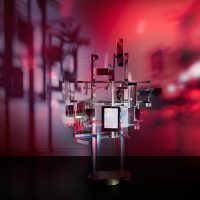The planning and preparations of this exhibition took many years. The major aim of the curators was to help the rediscovery of the „magician of light”, the artist, who died in 1992. This is consonant with the fact that Unesco named 2015 the international year of light. Although there has been a Nicolas Schöffer permanent exhibit in his home town Kalocsa since 1980, his last major Hungarian exhibition was organized in 1982.
This new exhibition will put on centerstage those sculptures which were preserved in the former studio of the artist and are still in the possession of his widow. The objects displayed were selected from the immense material preserved in the artist’s former studio. The main emphasis of the exhibition is layed on those spatio-dynamic and lumino-dynamic sculptures which brought renown for the artist, but some of the early paintings – as Schöffer started his career as a painter – will also be displayed and some of his architectural designs and urban planning drawings, never realized, will be included.
Aesthetically, the sculptures of Schöffer were considered to be pioneering, hypermodern works of art in his age. Kibernetic sculptures seemed to transform urban spaces by not only being present but also entering into a dialogue with and reacting to their environment, such as the weather, sound and light conditions in different ways. They can be interesting today in comparison with the ever faster digital revolution since then. The works of Schöffer create a futuristic-retro atmoshpere and confront us with how the future was seen to develop fifty years ago.

